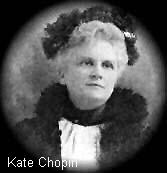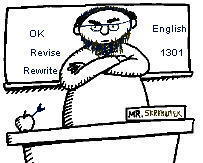

Tone is the last element of literary analysis that you will consider in this course. The first element, central idea, gauges the reader's intellectual reaction to the story. Tone, on the other end of the spectrum, gauges the reader's emotional reaction to the story. Both reactions are created by the author's fashioning of the story. When you analyze tone, you must tell how the author has used the elements of fiction to create the emotional reaction in the reader.
As forecast in the Assignment 3 Lecture, you have written two kinds of analyses in this course. One is the paragraph by paragraph analysis used in Assignments 2-4 and this assignment. The other kind, an integrated discussion of the relationship of three or more elements, is used in Assignments 5-7. The C exam will use the paragraph by paragraph structure, and the B and A exams will use the integrated discussion of the related elements.
*Remember, all students are required to write the Assignment 8 analysis.
 Contents
Contents
What Is Tone?
Dominant Elements
Analyzing Tone
Qualifying to Write the C Exam
Writing the Assignment 8 and C Exam Analysis
Sample Assignment 8 and C Exam Analyses
ASSIGNMENT 8 REQUIREMENTS
Guidelines for Submitting Your Assignment Files

A Storm of Passion
Kate Chopin's "The Storm" is a sensual short story about a woman's repressed sexuality. Calixta, the central character, is stifled by the social and sexual confines of her marriage to Bobinot. When old flame Alcee rides up to her house during a thunderstorm, Calixta's offer of shelter becomes much more, and the two lovers rekindle their old romance. After the encounter, the sun comes out, and all the characters are happy. CHOPIN USES ALL THE ELEMENTS EFFECTIVELY TO ACHIEVE HER CENTRAL IDEA THAT EXTRAMARITAL SEXUAL FULFILLMENT CAN PROVIDE HAPPINESS AND STRENGTH TO A STAGNANT MARRIAGE.
At the beginning, Calixta is an unsatisfied woman, though she is only vaguely aware of her situation. Calixta is unfulfilled sexually, her beginning key trait. Her marriage is without passion. Just as the heat in her house is stifling, so is Calixta stifled in the sexual and social confines of her marriage to Bobinot. The first indication that Calixta will do something to ease her problem is when she loosens the collar of her jacket as she is sewing. As she does so, she becomes aware of the approaching storm. When Alcee arrives seeking shelter from the storm, Calixta "unconsciously betrayed a sensuous desire." She soon gives in to her passion, and as the storm builds to a climax, so does her lovemaking with Alcee. By the end, Calixta is sexually fulfilled and content, her ending key trait, showing her to be a dynamic character.
Calixta is first seen sewing, suggesting her family role. She is "greatly occupied and did not notice the approaching storm," suggesting that she is a passive protagonist; she is not truly aware of her internal discontent. Soon, though, she loosens her collar to relax her sense of confinement. As the storm mounts and Alcee arrives, Calixta's central conflict becomes increasingly apparent. Her lack of sexual fulfillment is in conflict with her passion and desire for fulfillment, which she does not receive from Bobinot. As the storm intensifies, so does her sexual intensity, and she and Alcee make love. The couple climax as the storm climaxes, and these dual climaxes also mark the climax of the story. After the climax, the storm subsides and the sun comes out. All are happy, suggesting Calixta's conflict has ended well; she is fulfilled and content at the end of the story.
The story is set in the bayou country of Louisiana in the 1890s. In this setting, there is a clear distinction between the rich planter class of Alcee and the lower class of Calixta. The class differences and the adulterous relationship both add to the tension of the story. But the main aspect of the setting is the storm itself, which mirror's Calixta's sexual intensity. The storm arrives after a two-year drought; the drought suggests Calixta's lack of fulfullment, and the storm signals the release of her pent-up sexual energies. Appropriately, the development of the thunderstorm and the development of Calixta's encounter with Alcee parallel one another throughout the story, an excellent use of setting to suggest conflict.
The author uses the third-person omniscient point of view to tell her story. This point of view is effective because it allows Chopin to present the actions and feelings of all her characters. Though the focus of the story is clearly on Calixta and Alcee, this point of view shows the reader the actions and reactions of the minor characters, such as Bobinot and Bibi at the store, and especially Clarisse in Biloxi. The romantic encounter of the two lovers is presented as though through a soft filter, Chopin's chosen point of view, and the concerns of the other characters are also presented to make them both sympathetic and prosperous, as all the characters seem to gain something positive through the affair. The detached, omniscient point of view also gives the narrative voice a godlike quality that is able to deliver a controversial central idea, that such a romantic affair can actually benefit a marriage, and make it seem thoroughly acceptable to the reader.
Chopin uses symbolism throughout her story. Most of the symbols deal with the setting. Calixta's lack of sexual fulfillment is symbolized by the long drought in the area and by the separate beds that Bobinot and Calixta sleep in. The approaching storm suggests her pent-up sexual energy. The first physical contact between Calixta and Alcee coincides with a lightning bolt, suggesting the electricity in their encounter. As the two lovers become more intense, so does the fury of the storm. The two lovers climax as the storm climaxes, and the gentle retreat of the storm parallels their exhaustion after lovemaking. Just as the symbolic storm has released pent-up energy, so too have Calixta and Alcee vented the repressed sexuality of their physically unsatisfying marriages. Chopin uses the golden brightness of the sunlight following the storm to suggest the happy ending. The symbols help to reveal Calixta's internal conflict, her dynamic character, and the positive tone of the story.
Though Bobinot tries to be a good husband, he simply cannot fulfill Calixta's fiery passion. Because Calixta is a positive character, the reader regards her desire with sympathy and compassion. When she is finally able to satisfy her desire, the reader feels happy for her. The author further reinforces the dominant happy tone through the use of setting, having the bright sun come out after the dark storm passes. The author is quite direct as she notes: "So the storm passed and everyone was happy."
Many short stories deal with characters who are not satisfied with their roles in life. Kate Chopin's Calixta is such a character. Chopin challenges the reader by placing Calixta in an extramarital affair and then suggesting that such an affair can be beneficial to all concerned. Though such a central idea might not be acceptable to many readers, Chopin has nevertheless crafted an excellent short story that clearly conveys her central idea.
The sample analysis is about 1000 words long. Your Assignment 8 analysis must be at least 700 words long. Your Assignment 8 analysis must be at least eight paragraphs long.
Notice in the introduction in this sample that the title and author are clearly indicated, as is the identity of the central character. Only key events are presented, and the central idea (capitalized) is in the form of a complete statement. The body paragraphs give information about each element and its relation to the central idea, including the components listed in the "Writing the Assignment 8 and C Exam Essays" above.
Paragraph 2 should discuss the central character and any important minor characters. Identify the central character's beginning key trait and ending key trait, and indicate whether the character is static or dynamic.
Paragraph 3 should discuss the central conflict and any important minor conflicts. Specify the central conflict of the story, which should be an internal conflict. Indicate the climax of the story and its outcome.
Paragraph 4 should discuss the setting of the story. Identify the time and place of the setting, and then indicate the importance or function of the setting. Does the setting influence the actions of the central character? Does the setting serve as a conflict for the central character? Is the setting symbolic?
Paragraph 5 should discuss the point of view of the story. Identify the specific type of point of view used in the story. If the point of view is first-person or third-person limited, identify the narrator or narrative focus. Point out the sensibilities or function of the point of view. Why did the author choose this point of view? What does this point of view add to the story? Is the point of view reliable?
Paragraph 6 should discuss the use of figurative language in the story. Does the author use symbolism, irony, or allusion to enhance the meaning of the story? Are other elements of the story used in a symbolic or ironic way? Be sure to explain the symbols, ironies, or allusions. Do not simply list them.
Paragraph 7 should discuss the dominant tone of the story. Identify the dominant tone. Identify and discuss at least two elements most instrumental in achieving that tone.
Paragraph 8 is the conclusion of the essay. The conclusion should restate the thesis in a general manner and elaborate on the central idea. The conclusion should also include some evaluative comment on the quality of the story.
Your C exam will be similar to your Assignment 8 analysis, except the C exam is a bit shorter (minimum 600 words) and you are required to deal with only three elements plus the central idea if you so choose.

*Remember, all students must write the Assignment 8 analysis.
First, read a story from the list below. Reading the story at least twice is recommended. These stories are in Fiction 100.
Assignment stories:
Second, write an analytical essay of at least eight paragraphs like the sample analysis above in the Assignment 8 Lecture. Use the referential-interpretive purpose to write your analysis.
Note: Your analysis must contain all the components noted in the "Writing the Assignment 8 and C Exam Analyses" section of the Assignment 8 Lecture.
If you are not sure how to submit your assignment file by now, review the guidelines at this link to Assignment 2.